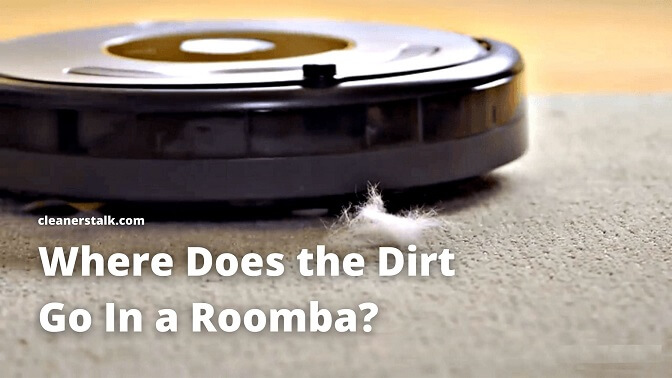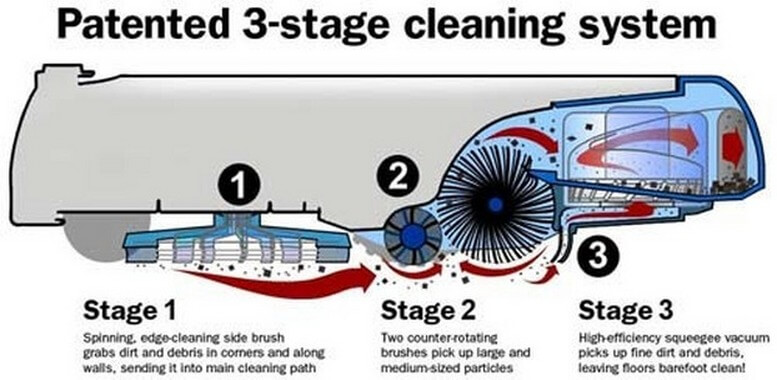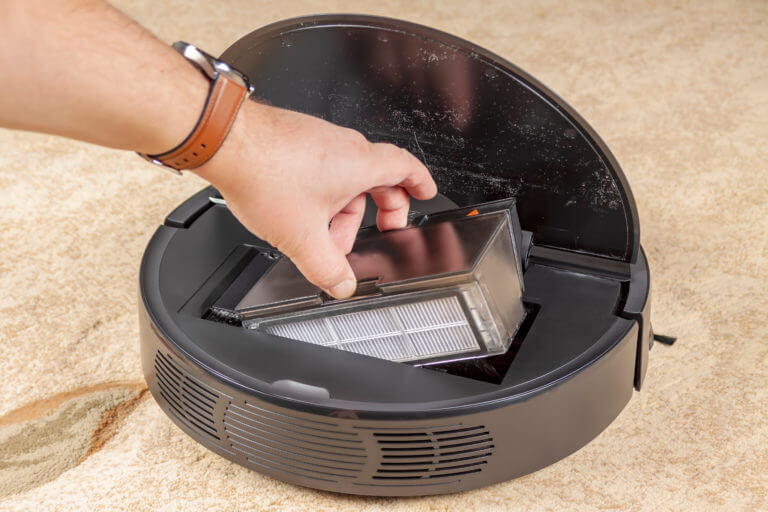
Where Does the Dirt Go in a Roomba? (Read This First)
Cleaners Talk is reader-supported. This post contains affiliate links, we may earn a commission at no additional costs to you. As an Amazon Associate we earn from qualifying purchases.
If you’re new to robot vacuums, or sometimes called Roombas, then you may be wondering where all the dirt goes when it’s cleaning your house. After all, how can such a relatively small machine carry that much dust whenever it moves around, right? Let’s take a look underneath a Roomba to see how it will cleans...
Where does the dirt go in a Roomba? Whenever a Roomba vacuums and collects dirt, it goes directly into the dustbin. Every Roomba is equipped with a dustbin located underneath the body to store all the dirt it picks up. You need to empty the dustbin once it’s full to let the Roomba continue cleaning.
In this article, we answer two of the most commonly asked questions about a Roomba, including: where does the dirt go in a Roomba, and how much dirt can it hold? By taking the time to understand these wonderful cleaning machines, you can utilize them to make your house cleaner than ever before.
1. Where Does the Dirt Go in a Roomba?
As mentioned in the beginning of this article, all the dust and dirt go into the dustbin (sometimes known as a dirt bin) found on the underside of a Roomba. Ideally, you need to empty the dirt bin at least once for each room the Roomba vacuums, and possibly two or three times depending on how dirty your floors are.
There's no vacuum bag in a Roomba -- you just empty the dustbin and insert it back in the unit. To get a better idea on how a Roomba works to pick up and store dirt, it’s best to familiarize yourself with the amazing three-stage cleaning system, a unique system found only on iRobot Roomba vacuums.
The Three-Stage Cleaning System

A Roomba picks up an amazing amount of dirt, pet hair, and other debris with its patented three-stage cleaning system. The iRobot’s three-stage cleaning system is unique and can only be found on Roombas. This patented cleaning system works to provide a thorough cleaning for every pass regardless of floor types.
Stage 1: A spinning side brush cleans along walls and edges, collecting dirt and gently guiding it into the path of the Roomba’s counter-rotating brushes. A Roomba only has one side brush, found in the top corner of the Roomba’s underbelly.
Stage 2: Two counter-rotating brushes act like a dustpan and broom, which lift dust, debris, and hair off the floor and into the dustbin. The first brush loosens, lifts, and pulls in debris and the second accelerates it into the suction channel.
Stage 3: The Roomba’s powerful vacuum sucks any dirt, dust, and hair off the brushes and deposits them directly into the dustbin. Once the dustbin is full, you need to empty it before the Roomba goes back to work.
Additionally, the optimized airflow guides the dirt, debris, and small particles to the back of the dustbin, which enables the dustbin to fill more evenly. This allows you to empty the dustbin less often, and gives you another reason why you should consider a Roomba if you want less work around your house.
2. How Much Dirt Does a Roomba Hold?

Every Roomba is equipped with a dustbin to hold all the dirt it collects.
Perhaps one of the most underrated features of a Roomba is its dustbin or dirt bin capacity. This is the maximum amount of dust and dirt the bin can hold before it needs to be emptied. Often, many Roomba buyers spend too much time focusing on the robot’s suction power, battery life, and mapping technology.
However, it’s easy to overlook the importance of dustbin capacity on the overall performance of a Roomba. For one, it promotes more cleaning time. The bigger the capacity, the longer it can run without needing your help to empty its bin. So before you buy a Roomba, be sure to consider its dirt bin capacity too.
So, how much dirt does a Roomba hold?
Generally, a Roomba can hold between 400 to 600 ml of dirt in its dustbin, or about 13 to 20 oz. For reference, that’s between 1.5 to 2.5 cups of pure dust and dirt. The iRobot Roomba s9 can hold as much as 400 ml of dirt, while the Roomba 980 has a fairly generous dirt capacity of 600 ml.
If you’re curious about which Roomba holds the most dirt, here’s the complete list of the most notable Roomba model’s dirt bin capacity from the lowest to the highest:
- Roomba 890 = 300 ml
- Roomba i7 = 400 ml
- Roomba s9 = 400 ml
- Roomba e5 = 500 ml
- Roomba i7+ = 500 ml
- Roomba 690 = 600 ml
- Roomba 980 = 600 ml
- Roomba 960 = 600 ml
- Roomba 860 = 650 ml
Newer and more advanced Roomba models, like the Roomba i7+ and s9+, are smart enough to empty their own dustbins. Both come with a CLEAN BASE Automatic Dirt Disposal that cleans up after itself. Households with pets and heavy foot traffic could benefit from buying either the Roomba i7+ or the s9+
The CLEAN BASE can hold about 30 times the volume of the Roomba’s dustbin, or about 30 dustbins at a time. Depending on how dirty your floors are, it can take about 60 days before you need to replace the dust bag (on the CLEAN BASE). You can simply forget about vacuuming for months at a time.
Bottom Line
And there you have it, the answer to the question: where does the dirt go in a Roomba? The dustbin is an important part that contributes to a Roomba’s cleaning effectiveness. Moreover, knowing how much dirt does a Roomba hold is equally important too. Now you know how amazing Roombas can be. 🙂
PRO TIP: Does your house have dark floors? Robot vacuums are notorious for having a hard time on dark floors, especially black surfaces. If your house has dark floors, then you need to invest in the best robot vacuums for dark floors for your home. Plenty of Roombas made the list. After all, they’re equipped with top-of-the-line tech.
You may also want to read our comparison reviews:
